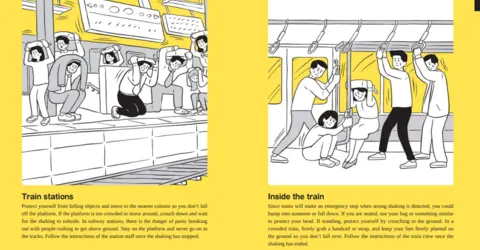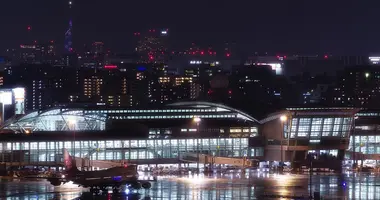What to do in the event of an earthquake in Japan? Useful information and instructions
- Published on : 23/09/2015
- by : N.P.
- Youtube
Here's a guide with advice, recommendations and information on how to react in the event of an earthquake during a trip to Japan, as the country is prone to these natural events on a fairly regular basis.
To view the instructions directly, click here.
*Updated August 16, 2024:
On August 15th, the Japanese government lifted the "mega-quake" advisory along the Nankai fault.
*Updated August 14, 2024:
Following the announcement of the possibility of a "mega-quake" by the Japanese authorities along the Nankai fault on August 8th, it's important to know what to do in the event of an earthquake in Japan, and where to find the right information. This is just as true for any trip to Japan as it is for any stay on the American West Coast, as the archipelago sees more than 1,500 earthquakes a year.
The following locations are currently subject to heightened vigilance. Most of Japan's most populous and visited prefectures, around Tokyo, Kyoto and Osaka, are not affected by the current "mega-quake" warning (though all coasts would be affected by a tsunami warning):

Japan lies at the crossroads of 4 major tectonic plates, and has a significant percentage of active volcanoes on its archipelago. This geological and geographical particularity explains the high number of earthquakes in Japan, around 1,500 per year. Most of these go relatively unnoticed, due to their low intensity, but some are frequently felt in varying degrees of intensity.
As you can imagine, the Japanese are well accustomed to living with earthquakes, and have been training themselves since childhood for the procedures to protect themselves in the event of an earthquake. Homes and buildings are also designed to withstand tremors and the damage they inflict. Japanese cell phones are also linked to the country's seismic warning system, alerting people to the arrival of an earthquake within seconds, giving them time to take shelter.
In addition to the familiar Richter scale, ranging from 1 to 10 and measuring earthquake magnitude, the Japan Meteorological Agency (JMA) has established its own reference, the Shindo scale, ranging from 1 to 7. It defines the energy released by an earthquake in a given place. This makes it easier to assess the risks to populations and infrastructures more accurately, and thus to organize evacuations and rescue operations on a priority basis.
As a traveler to Japan, the best thing to do is to be aware of existing local procedures, summarized below, and to follow the instructions given to you on site in the event of an earthquake in Japan. As the country is an archipelago, the occurrence of an earthquake is generally accompanied by a tsunami warning, so it's also a good idea to be informed about procedures in the event of an alert.

© Tokyo Metropolitan Government
What to do in the event of an earthquake in Japan?
As a general rule, it's recommended to imitate and follow the local population, who are trained to deal with earthquakes and the procedures to follow.
Here are some important guidelines if you feel tremors in Japan, depending on where you are located:
Inside a building
- The main danger is falling objects/furniture/parts of buildings.
- Take cover as quickly as possible under a table, desk or other piece of furniture.
- If you can't take shelter, cover your head and body with whatever you have nearby.
- When the shaking stops, open doors and windows to ensure you have an escape route before any aftershocks arrive.
- When the shaking stops, if you were cooking/using your gas stove, turn everything off as quickly as possible. For information, in the event of a major earthquake, gas supplies will be automatically cut off.
If an earthquake occurs at night, while you're sleeping
- As a general rule, try not to sleep near anything that could fall on you during an earthquake
- If there's room under your bed, take shelter there.
- If not, use your pillows and blanket to protect your head.
In a supermarket/store
- Move away from the shelves to avoid falling products.
- Stay close to the floor and protect your head.
- Follow the instructions of the staff, who are trained for seismic situations.
At the hotel
- Hotel staff are trained to deal with earthquakes. Follow their instructions.
- Every hotel has a survival kit and food supplies for the number of occupants.
In an elevator
- Elevators are programmed to stop automatically in the event of a major earthquake, and to open at the nearest floor. Get out as quickly as possible and take shelter as described above.
- If the elevator does not stop automatically, press the buttons on all floors, and exit at the first available floor. Then take cover as described above.
- If the elevator is blocked, press the call for help button and wait for help to arrive. Do not try to get out on your own.
Outside on the street
- The main danger is falling broken glass or debris from nearby buildings.
- Keep as far away from the buildings as possible, and stay in the middle of the street.
- Use a bag or anything you can find nearby to protect your head.
- Take refuge in an open space, such as a park or garden.
- Tip: follow the flow of Japanese people, who know the nearest evacuation centers in the event of an earthquake.
In public transportation/trains/in stations
- On board a Shinkansen, the train will be brought to an emergency stop by an automatic system as soon as tremors are detected.
- On-board personnel are regularly trained in the event of an earthquake. Follow their instructions.
- In the station, stay away from the edge of the platform and protect your head.
- Follow the instructions of station personnel once the shaking has stopped.
- If you're in an underground station, watch out for crowds heading for the exits.
- Underground, stay close to pillars and walls until the shaking has stopped.
- In the event of an underground power cut, always keep one hand along the wall as you move forward to avoid getting lost.
By the sea/river
- The main danger is the arrival of a tsunami.
- There's no point in trying to escape in the short term. The speed of a tsunami is much faster than the means of transport available. It's a lost race against time.
- Take refuge on the highest building you can reach on foot, or in the case of a fishing village, the local temple or shrine, often built on an elevated mound.
- Remain sheltered until the tsunami warning is officially lifted.
After the earthquake
- Aftershocks can occur in the minutes and hours following an earthquake. Stay alert and be prepared to take shelter again.
- Stay away from damaged buildings, structures and damaged areas.
- Follow official instructions.
- If you can, give first aid to those around you, if injured.
- Head for evacuation centers and shelters. A good reflex is to follow the local population, who train for this kind of event and know where to go after a natural disaster.
Assistance
- Contact your local embassy.
- Use NTT's emergency line: the Japanese telephone operator allows you to leave a recorded message on its emergency line (171) to inform your loved ones of your situation and facilitate the search. If the telephone network is saturated, the operator will make the use of all phone booths free of charge.
- Of course, you can also get in touch with Japan Experience, and we'll help you with your travel arrangements.
Useful resources
As mentioned above, the most important thing is to be informed about earthquake procedures, or at least to know where to find them. Here are some useful resources, aimed at Japanese residents, but which may be of use to you as visitors:
- The "Disaster Preparedness Tokyo" guide published by Tokyo City Hall
- Information on current earthquakes in Japan on the JMA website










